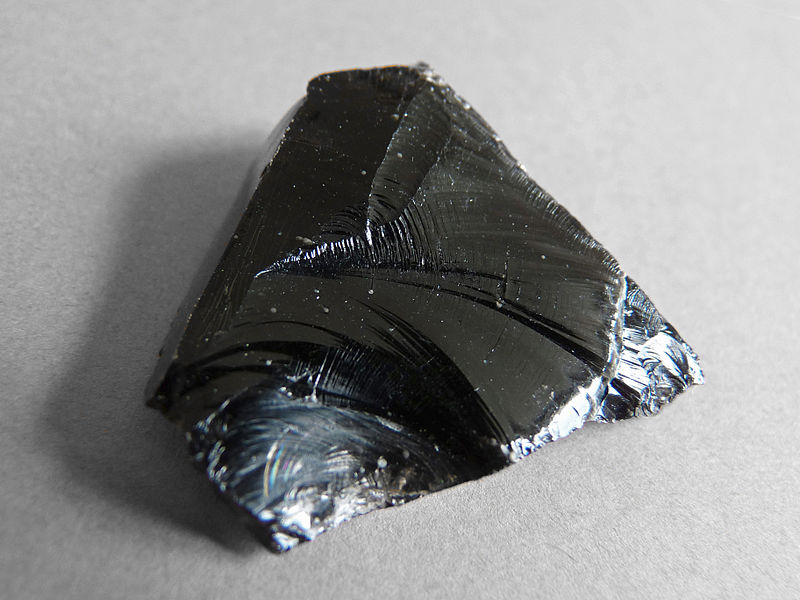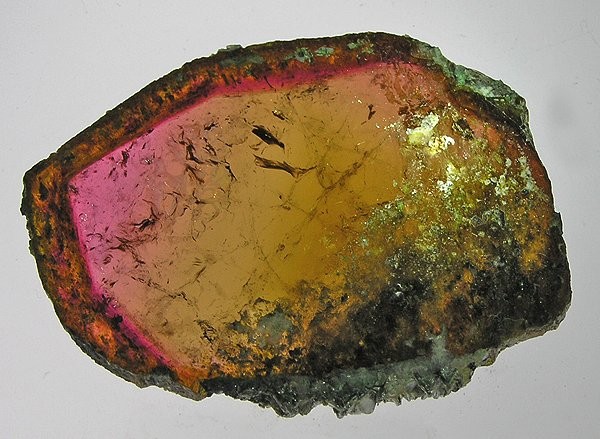What is the Difference Between Obsidian and Tourmaline
The key difference between obsidian and tourmaline is that obsidian is a non-crystalline material, whereas tourmaline is a crystalline material.
Obsidian and tourmaline are inorganic substances. Tourmaline is a crystalline mineral, but obsidian is not a mineral because it is not crystalline and it has a variable chemical composition.
CONTENTS
1. Overview and Key Difference
2. What is Obsidian
3. What is Tourmaline
4. Obsidian vs Tourmaline in Tabular Form
5. Summary – Obsidian vs Tourmaline
What is Obsidian?
Obsidian is a mineral-like compound that forms from lava extruded from a volcano which is cooled rapidly with minimal crystal growth. It is a type of naturally occurring volcanic glass. It occurs as a type of igneous rock. This material appears in deep black or blackish green color, and its fracture is conchoidal. It has a hardness of about 5-6 in the Mohs scale of hardness. Obsidian has a vitreous luster and is a translucent mineral. Moreover, it has a texture that is smooth and glassy.

Usually, obsidian substances form from felsic lava, which is rich in elements such as silicon, oxygen, aluminum, sodium, and potassium (light elements). This type of lava occurs commonly within the margins of rhyolitic lava flows. These are known as obsidian flows. Obsidian flows are rich in silica, which gives it a high viscosity. It tends to inhibit the diffusion of atoms through the lava (which in turn tends to inhibit the first step of the mineral crystal formation).
Typically, obsidian is a hard, brittle, and amorphous mineral. Therefore, it fractures with sharp edges. Historically, this mineral was useful in manufacturing cutting and piercing tools, experimentally as surgical scalpel blades, etc. Currently, it is useful in manufacturing sharp knives, scalpel blades, ornamental purposes and as a gemstone.
What is Tourmaline?
Tourmaline is a boron silicate mineral having chemical elements such as aluminum, iron, magnesium, sodium, lithium, or potassium. It is a crystalline mineral substance we can name as a semi-preciuos stone.

The crystal system of tourmaline is trigonal and it comes under the ditrigonal pyramidal crystal class. Moreover, this substance appears mainly in black color, but it can also have a range of colors that varies from colorless to brown, red, orange, yellow, green, etc. The cleavage of this mineral is indistinct and its fracture is uneven because it is brittle. The hardness of this mineral is about 7.0 to 7.5 in the Mohs scale of hardness. It has a vitreous luster and the mineral streak color is white.
What is the Difference Between Obsidian and Tourmaline?
Obsidian and tourmaline are inorganic substances. Tourmaline is a crystalline mineral, but obsidian is not a mineral because it is not crystalline and it has a variable chemical composition. Obsidian is a mineral-like compound that forms from lava extruded from a volcano which is cooled rapidly with minimal crystal growth whereas tourmaline is a boron silicate mineral substance having chemical elements such as aluminum, iron, magnesium, sodium, lithium, or potassium. The key difference between obsidian and tourmaline is that obsidian is a non-crystalline material whereas tourmaline is a crystalline material.
The below infographic lists the differences between obsidian and tourmaline in tabular form for side by side comparison.
Summary – Obsidian vs Tourmaline
Obsidian is a mineral-like compound that forms from lava extruded from a volcano which is cooled rapidly with minimal crystal growth. Tourmaline is a boron silicate mineral substance having chemical elements such as aluminum, iron, magnesium, sodium, lithium, or potassium. The key difference between obsidian and tourmaline is that obsidian is a non-crystalline material, whereas tourmaline is a crystalline material.
Reference:
1. “Multipurpose Uses of Tourmaline You’ll Be so Thankful to Know.” Crystal Benefits, 8 June 2010.
Image Courtesy:
1. “Lipari-Obsidienne (5)” By Ji-ElleIt feels nice and warm… Own work (CC BY-SA 3.0) via Commons Wikimedia
2. “Tourmaline-121240” By Rob Lavinsky, iRocks.com – (CC-BY-SA-3.0) via Commons Wikimedia
ncG1vNJzZmivp6x7pbXFn5yrnZ6YsqOx07CcnqZemLyue9ahmK1lmah6tbTEZpuinpaav6a6wp5km52krLKmuoyomayhlJ6ur3nAp5tmrJ%2Bqv66ty6Klnmc%3D